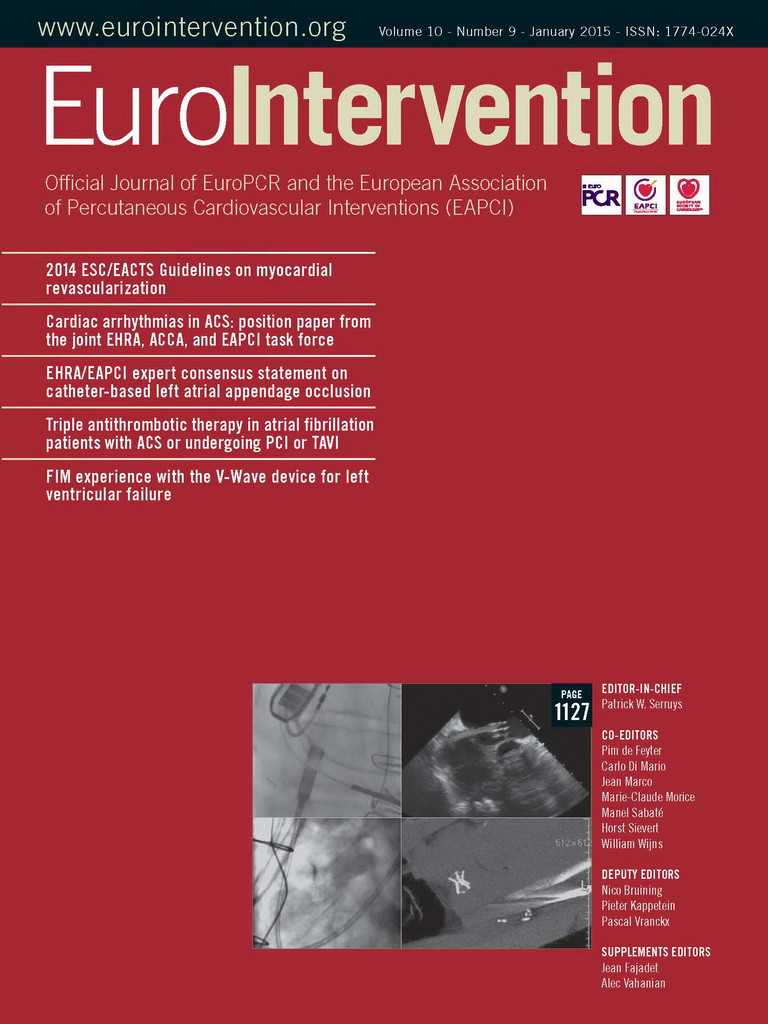This first issue of EuroIntervention in 2015 is a unique affair. Unique since it is an issue predominantly focused on guidelines and expert consensus papers within our field of interventional cardiology. Naturally, the optimum moment for dissemination of the guidelines and expert consensus papers is during the annual ESC meeting, in this case as online documents last year in Barcelona. Today we publish in print four documents with a direct relationship to our interventional subspecialty and, as such, the importance of these documents cannot be overstated for the EuroIntervention readership.
Since 2002, the ESC has prepared and published 35 guideline papers. These guidelines aim to present all the relevant evidence within a particular field of cardiology to help cardiologists weigh the benefits and risks of a diagnostic or therapeutic procedure. These guidelines are valuable tools for the consideration of decisions in daily practice.
The Task Force on Myocardial Revascularization of the European Society of Cardiology (ESC) and the European Association for Cardio-Thoracic Surgery (EACTS), with the special contribution of the European Association of Percutaneous Cardiovascular Interventions (EAPCI) and led by Stephan Windecker and Philippe Kolh have successfully managed what was obviously a mammoth task when one considers the length of the document and also the valued input from the various members of the task force1. Consider this fact alone; in the development of the myocardial revascularisation guidelines, over 100 randomised clinical trials (RCTs) involving 93,553 patients with 262,090 patient-years of follow-up were analysed. The authors should be wholeheartedly commended for this great endeavour.
In this issue, besides the publication of the ESC myocardial revascularisation guidelines, two EAPCI related position papers are also featured. The first is on cardiac arrhythmias in acute coronary syndromes, which is a position paper from the joint European Heart Rhythm Association (EHRA), the Acute Cardiovascular Care Association (ACCA) and EAPCI task force2, and the second is the EHRA/EAPCI expert consensus statement on catheter-based left atrial appendage occlusion3.
It is worth noting that there is a difference between expert consensus and position papers and guidelines. Marco Valgimigli and Robert Byrne, chairs of the EAPCI Scientific Document Committee (SDC) have formulated quite nicely the differentiation between consensus/position papers and guidelines. They write that “expert consensus and position papers should be regarded as educational tools that help physicians formulate their clinical judgements and make independent diagnostic and therapeutic choices. Such documents supplement guidance and evidence produced in clinical practice guidelines by covering areas not specifically addressed or not addressed in detail by existing guidelines. They are also ideally placed to identify emerging topics and areas in the field of interventional cardiology. The difference from clinical practice guidelines is that expert consensus and position papers may state recommendations on a specific subject, but these recommendations are not graded by class or level of evidence”. We look forward to seeing in this coming year the first results of the EAPCI Scientific Document Committee’s work.
To complete the quartet of EAPCI documents, a new updated joint consensus document was recently published by the ESC Working Group on Thrombosis, EAPCI, EHRA, and the European Association of Acute Cardiac Care (ACCA), and endorsed by the Heart Rhythm Society (HRS) and the Asia-Pacific Heart Rhythm Society (APHRS) entitled “Triple antithrombotic therapy in atrial fibrillation patients with acute coronary syndromes or undergoing percutaneous coronary intervention or transcatheter aortic valve replacement”4. Although the only one of these four documents not to be jointly published in EuroIntervention, Davide Capodanno, Gregory Lip and Robert Byrne have kindly summarised the most important aspects of this consensus document in an extended editorial5.
One final thought, is that while I’ve focused in this editorial on our European interventional cardiology professional documents, Valentin Fuster wrote recently of the need for “cross-continental coordination of guideline development and issuance”6. His call is something that I’m sure many will seek to answer, as the reward would help in achieving superior care for all patients on both sides of the pond.
And finally, many readers will notice that EuroIntervention has this month started to use the e-article format. As submission numbers continue to grow quite rapidly, one challenging aspect of this success is that there has been an increase in the number of accepted papers awaiting proof production and publication. To cope with this, and to shorten the time period from acceptance to publication, the EuroIntervention Editorial Board now offers the online-only “e-article” format. This format ensures that selected papers will be published and indexed at PubMed in a more timely manner. The e-article is listed in the print table of contents and is highlighted with a special logo so that readers will know where and how to access the full e-article. The e-article, like all other EuroIntervention articles, is free of charge to view and to download as a PDF at the EuroIntervention website. The e-article will be presented in full as part of the regular issue online and therefore has the same academic value as a printed article.

